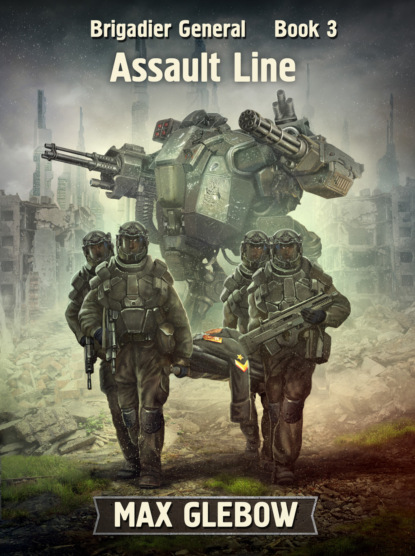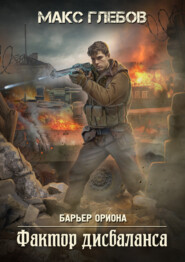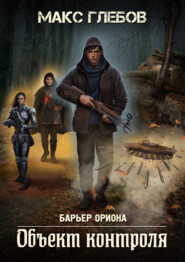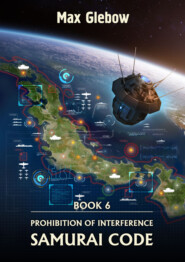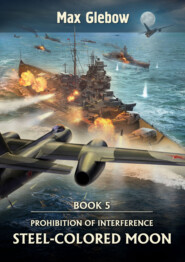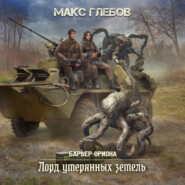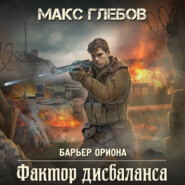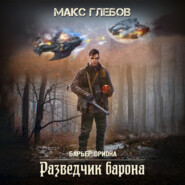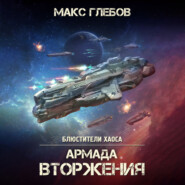По всем вопросам обращайтесь на: info@litportal.ru
(©) 2003-2025.
✖
Assault Line
Настройки чтения
Размер шрифта
Высота строк
Поля
Chapter 3
We entered the quarg space in five separate groups. The ships of Admiral Nelson that accompanied our transports were far behind, because they weren’t equipped with our latest versions of the EW stations. Taking these ships with us to the enemy’s rear meant only exposing them to an unjustified risk and putting the entire operation on the verge of breakdown.
The autonomous space docks, where the quargs were building their giant ships, were located in five enemy-controlled star systems located quite far apart. We were therefore forced to take our ships to the assault line independently of each other, having agreed only on the exact time of the operation. The simultaneous onset of the attack was required to provide the surprise upon which my plan relied heavily.
Admiral Bronstein was right to call our operation an adventure. It could not have been anything else, given the terrible lack of time and resources we experienced in preparing this operation. RWC and GWI barely made the torpedoes and command planes we needed, and the conversion of the transports into half-recon ships, half-aircraft carriers was so difficult that sometimes I had to stay on the docks 24 hours a day. The result was still something that should have been called sub-recon-sub-aircraft-carriers. The medium-size troop transport is a pretty good carcass. It’s not a cruiser, of course, but it’s much larger than a destroyer, just try to camouflage it… We didn’t have enough time to make processors for EW stations, let alone set them up and adjust the settings. The outcome was much sadder than I had imagined, but now it was too late to regret it, we were flying into the jaws of the toads, ugh, of the quargs.
Each of our groups included one medium-size recon ship, which had been upgraded in the same way that the ship Yoon Gao and I flew on the reconnaissance raid. The task of these ships was to observe the tests. Whatever happened, they had to come back and report the results of the attack. Two groups consisted of only one transport and a recon ship. Their task was to destroy single autonomous space docks with unfinished battleships. Two other groups consisted of a recon ship and two transports and went to the systems where the quarg shipyards were located in pairs.
I was in the largest group that has been moving toward the most densely populated system we’ve discovered in the last raid. The four autonomous space docks in it were located in orbit of the sixth planet, which was a gas giant, as was customary.
Our four transports and a recon ship emerged from hyper-space beyond the borders of the system. For two days, we were slowly and cautiously navigating through the asteroid outer belt, probing the space with the best scanners that Engineer Jeff and Professor Stein were able to assemble on the basis of the new processors. Fortunately, we didn’t have to go deeper into the central areas of the system where terrestrial planets revolved around the local sun here. It was much easier to run into a quarg patrol or a network of fixed scanners there than on the outskirts of the system, although we had no doubt that the docks would be heavily guarded. We were just counting on the patrol force to relax and grow lazy over the years of quiet service, and their vigilance has faded, albeit a little.
Whether it was true, or whether the new generation of EW stations was successful, but we have gone undetected to the assault line and even with some time left. The transports gently extinguished speed and hovered in emptiness, and the recon ship moved a little closer to the target and launched a compact probe. A few hours later, the probe returned, and we received three-dimensional images of our targets.
I didn’t trick the Minister of Defense, we were really almost late. From the looks of the battleships, their preparedness was approaching 80%. Almost all of the outer hull had been installed on the two ships, and now the main-caliber towers were being mounted.
Well, our waiting time has come to an end, and the transports have begun to accelerate toward the targets. An hour later, the doors of the holds went sideways and the catapults pushed the command machines and our new torpedoes from the inside of the ships. We planned to fire 50 torpedoes at each dock. The command planes scattered in different directions, taking ten torpedoes with them, to provide for a simultaneous attack on the dock from multiple directions, and the ships turned aft ahead and proceeded to smooth braking.
“Detected by the enemy!” reported Bridgetown Transport Commander, Lieutenant Commander Bosworth.
“Accelerate immediately and jump out of here!” ordered I, watching as the quargs’ guarding forces regroup and gain speed to attack the detected ship, “The machines you’ve released, we’ll pick them up ourselves.”
“Permission to raise pursuit planes from Bridgetown, Captain, Sir?” Commander Matveev asked me. Nelson assigned him to me as commander of the pursuit planes transferred to us from aircraft carrier Windhoek. Eight planes were based on each of the transports. Just in case, as Nelson explained to me, and I didn’t mind, anyway, we didn’t have time to make enough torpedoes to fill the ships, and there was still room.
“I think it’s time,” I nodded, “Let them attempt to bind the enemy’s corvettes by battle and lead them away.”
The problem was that the machines transferred to us from Windhoek had a standard fleet configuration, and in terms of camouflage parameters, they did not compare with the command planes and torpedoes of our manufacture, so the only way to release them was from ships already discovered by the enemy, or they would just disclose us. As a result, only eight pursuit planes entered the battle against the light forces of the quargs, which were pressing hard the transport gathering speed.
Meanwhile, Bridgetown’s situation was becoming hopeless. Quarg forces were based not only on the sixth planet, but also at other points in the system, including behind our backs. We bypassed them, hiding behind the camouflage umbrella of EW stations, but the ship that had been discovered could not escape. The unarmed and, by and large, the non-combat ship was unable to counteract the corvettes and destroyers. A bright flare at the place of the transport ended this brief battle. By the time the ship was destroyed, all eight pursuit planes released from it had already been shot down, it turned out to be inevitable because of the major inequality in strength.
Three of our transports, still undetected, hovered in the void, waiting for events to unfold. A wave of torpedoes led by command machines continued to make their way cautiously to the targets, bypassing enemy ships and stationary scanners as far as possible. The pilots of the command pursuit planes were finding it increasingly difficult to do so, because enemy activity around the sixth planet has increased significantly.
The surprise element was lost, but the torpedoes were not far from the target. “What are we going to do, Commander, Sir?” asked me the transport commander, “The probability of our detection is increasing by the minute. The quargs are pulling forces from the entire system.”
“Just waiting,” I answered with demonstrative calmness, “If we turn the engines on, we’ll almost certainly be spotted. We wait for the torpedoes to strike. Maybe in the mess we can slip away.”
“Detected by the enemy!” The report came from one of the command machines. Not far from the planet, by cosmic standards, there was a short fight. Our pursuit plane has taken counter-courses with the enemy’s corvette. There was no comparison between the ship weights, but the pursuit plane, quick-moving and very well-protected by electronic warfare means, slipped away from the rockets and anti-aircraft shells, and fired two light missiles at the enemy. The only way they could do serious damage to a spaceship was with good luck, but the pilot of the discovered pursuit plane was not actually going to do it. He sought to complete his task.
The torpedoes, abandoned by the pilot during the battle, again sensed the steel strings of the control signals and they rushed after the command machine to the autonomous space quarg dock, doing desperate chaotic jerks and evasive maneuvers. The anti-aircraft systems of the dock and the guarding ships were hitting the dangerous enemy with shells and missiles. Torpedoes were destroyed one by one.
The command machine pilot led his wards to the line from which they could attack the dock autonomously, and by a sharp maneuver he broke the distance with the dock full of anti-aircraft cannons. None of the ten torpedoes made it to the target.
The quarg gunners could only be applauded, but the destroyed torpedoes have done their dark work by diverting the attention of the enemy’s defense systems and ships. When forty more torpedoes came out of the void, the shipyard’s anti-aircraft systems were no longer able to cope with this deadly threat.
All four autonomous space docks were attacked almost simultaneously, as planned. The early discovery of one of the command machines had only facilitated this task. Titanic shipbuilding structures were covered by explosions of binary warheads of torpedoes. The shaped charge penetrated the hull and burned a path in front of it in order for the blast part of the torpedo to enter into the unfinished ship. The impact of several dozen of the most powerful munitions caused disastrous damage to the autonomous space docks along with the unfinished ships. One of the ships split into three pieces, which began to slowly spin into the gravity well of the gas giant together with the encircling structures of the destroyed dock. The nearest ship exploded without a sound. Only the quargs could be asked, what could possibly have exploded that way, but the spectacle turned out to be fascinating. The two remaining unfinished battleships were destroyed less spectacularly, but equally inexorably.
I didn’t need to give any commands. According to the operation plan, once the torpedoes were pulled out to the autonomous assault line, the pilots of the command machines were to return immediately to the transports, that, as we saw, they did.
The quargs were confused. Some of the enemy’s big commanders must have lost their temper, and for a while could not adequately lead their subordinates. In any case, the movements of enemy ships were haphazard, at least in our view. But it didn’t make it any easier, because there were too many quargs at the party we were having.
We picked up the returned command machines and, in principle, the plan was to start acceleration for the jump. We did our job, but not without loss. Except turning the transports’ engines on was tantamount to suicide. Of course, the camouflage wouldn’t completely come off, but it would be 40% down, and the space around us was crawling with enemy ships, and their numbers were growing by the minute.
“The odds of our detection in the next 30 minutes are estimated by the computer at 60%,” told me the commander of the transport, “It’s time to make a decision, Commander, Sir.”
“How many people do we have on board all three ships?” I asked a question that was unexpected to everyone.
“42 people,” answered Matveyev with a note of surprise in his voice.
“Commander Yoon Gao,” I called our scout on the laser-optical link, “How many people can you put on your ship if you don’t give a damn about all the rules and regulations and instructions? I have 42 people here who want to keep your crew company.”
“Captain, Sir, are you serious? You flew with me. We have a crew of five.”
“What if otherwise these 42 people just die?”
“Well…There’s nothing to think about, let’s have your passengers. Just how? ”
“Pull up close and open the outer hatch of the small cargo hold. Transports have a universal docking unit. We’re lucky we didn’t dismantle it. The rest is about the skills of the pilots.”
The modernized medium-size recon ship had an incomparably better camouflage than the transport, that’s what Yoon Gao and I have seen more than once during the previous raid, so without fear, he made a careful maneuver, approached three of our ships and joined the docking unit of the nearest transport.
The pilot of Yoon Gao’s ship clearly knew his business, or maybe Yoon himself was driving the ship now, who knows, but the docking was done with maximum accuracy.
“Pilots of the command machines, take positions in the pursuit planes and get ready to receive a combat mission.”
“Commander, Sir,” asked me Commander Matveyev, “Maybe my pilots should prepare for takeoff, too?”
“No way. Unless, of course, you want to ruin us all. From this distance, your machines will be like Christmas trees with garlands and balloons for the enemy. Only our command machines have a chance, so prepare your men for an emergency evacuation. Transport crews, leave the ships and prepare them for self-destruction.”
“Ready to take off,” our pilot’s commander reported.
“Pursuit planes, simulate an attack in the direction of the sixth planet with the task of diverting enemy forces from our ships. Do not engage in close combat, but keep the enemy as far away from here as possible. You need to hold on for 20 minutes. You’ll get further orders from the recon ship. Mission clear?”
“That’s right.”
“Do it!”
I have met the expression „to pack like sardines” before, but until now, I didn’t give it much attention, and it turned out I should. For the next 15 minutes, I had to feel the depth and lexical precision of this idiom the hard way. It was really cramped.
Three simultaneous flashes behind the stern of Yoon Gao’s ship marked the end of the active phase of our operation and the beginning of a painful journey home. It was especially distressing to us when the ship, already overcrowded, was filled with eight pilots of the surviving command machines, that caught up to us in 40 minutes. By the way, their passage to the ship has become a distinct headache, as the pursuit planes had no fixed docking units, but we managed somehow. The command machines had to be destroyed as well as the transports, because there was not the slightest possibility of getting them into space under human control.
When we arrived a week later at the rendezvous point with Admiral Nelson’s destroyers, half the passengers on our ship were unconscious. The life-support system for a maximum of 10 persons could not sustain five times as many people for an extended period. But as it turned out, we got off easy.
There were five scouts and only two transports at the rendezvous point, the ones that attacked the single-dock systems. Of the remaining teams, apart from the scouts who were not directly involved in the battle, only a few of the command machines’ pilots survived. Command pursuit planes have proved to be very survivable in combat conditions due to high speed, good maneuverability and excellent EW systems, which allowed them to evade missiles and deceive enemy scanners.
We lost 80% of the ships and half the people who took part in the raid, but eight out of ten nearly completed Titan-class battleships have ceased to exist. Unfortunately, the quargs were able to defend two shipyards.
On the way home, I couldn’t help but think that a few more docks with giant battleships being built we certainly couldn’t find in the first raid. But how many?
We entered the quarg space in five separate groups. The ships of Admiral Nelson that accompanied our transports were far behind, because they weren’t equipped with our latest versions of the EW stations. Taking these ships with us to the enemy’s rear meant only exposing them to an unjustified risk and putting the entire operation on the verge of breakdown.
The autonomous space docks, where the quargs were building their giant ships, were located in five enemy-controlled star systems located quite far apart. We were therefore forced to take our ships to the assault line independently of each other, having agreed only on the exact time of the operation. The simultaneous onset of the attack was required to provide the surprise upon which my plan relied heavily.
Admiral Bronstein was right to call our operation an adventure. It could not have been anything else, given the terrible lack of time and resources we experienced in preparing this operation. RWC and GWI barely made the torpedoes and command planes we needed, and the conversion of the transports into half-recon ships, half-aircraft carriers was so difficult that sometimes I had to stay on the docks 24 hours a day. The result was still something that should have been called sub-recon-sub-aircraft-carriers. The medium-size troop transport is a pretty good carcass. It’s not a cruiser, of course, but it’s much larger than a destroyer, just try to camouflage it… We didn’t have enough time to make processors for EW stations, let alone set them up and adjust the settings. The outcome was much sadder than I had imagined, but now it was too late to regret it, we were flying into the jaws of the toads, ugh, of the quargs.
Each of our groups included one medium-size recon ship, which had been upgraded in the same way that the ship Yoon Gao and I flew on the reconnaissance raid. The task of these ships was to observe the tests. Whatever happened, they had to come back and report the results of the attack. Two groups consisted of only one transport and a recon ship. Their task was to destroy single autonomous space docks with unfinished battleships. Two other groups consisted of a recon ship and two transports and went to the systems where the quarg shipyards were located in pairs.
I was in the largest group that has been moving toward the most densely populated system we’ve discovered in the last raid. The four autonomous space docks in it were located in orbit of the sixth planet, which was a gas giant, as was customary.
Our four transports and a recon ship emerged from hyper-space beyond the borders of the system. For two days, we were slowly and cautiously navigating through the asteroid outer belt, probing the space with the best scanners that Engineer Jeff and Professor Stein were able to assemble on the basis of the new processors. Fortunately, we didn’t have to go deeper into the central areas of the system where terrestrial planets revolved around the local sun here. It was much easier to run into a quarg patrol or a network of fixed scanners there than on the outskirts of the system, although we had no doubt that the docks would be heavily guarded. We were just counting on the patrol force to relax and grow lazy over the years of quiet service, and their vigilance has faded, albeit a little.
Whether it was true, or whether the new generation of EW stations was successful, but we have gone undetected to the assault line and even with some time left. The transports gently extinguished speed and hovered in emptiness, and the recon ship moved a little closer to the target and launched a compact probe. A few hours later, the probe returned, and we received three-dimensional images of our targets.
I didn’t trick the Minister of Defense, we were really almost late. From the looks of the battleships, their preparedness was approaching 80%. Almost all of the outer hull had been installed on the two ships, and now the main-caliber towers were being mounted.
Well, our waiting time has come to an end, and the transports have begun to accelerate toward the targets. An hour later, the doors of the holds went sideways and the catapults pushed the command machines and our new torpedoes from the inside of the ships. We planned to fire 50 torpedoes at each dock. The command planes scattered in different directions, taking ten torpedoes with them, to provide for a simultaneous attack on the dock from multiple directions, and the ships turned aft ahead and proceeded to smooth braking.
“Detected by the enemy!” reported Bridgetown Transport Commander, Lieutenant Commander Bosworth.
“Accelerate immediately and jump out of here!” ordered I, watching as the quargs’ guarding forces regroup and gain speed to attack the detected ship, “The machines you’ve released, we’ll pick them up ourselves.”
“Permission to raise pursuit planes from Bridgetown, Captain, Sir?” Commander Matveev asked me. Nelson assigned him to me as commander of the pursuit planes transferred to us from aircraft carrier Windhoek. Eight planes were based on each of the transports. Just in case, as Nelson explained to me, and I didn’t mind, anyway, we didn’t have time to make enough torpedoes to fill the ships, and there was still room.
“I think it’s time,” I nodded, “Let them attempt to bind the enemy’s corvettes by battle and lead them away.”
The problem was that the machines transferred to us from Windhoek had a standard fleet configuration, and in terms of camouflage parameters, they did not compare with the command planes and torpedoes of our manufacture, so the only way to release them was from ships already discovered by the enemy, or they would just disclose us. As a result, only eight pursuit planes entered the battle against the light forces of the quargs, which were pressing hard the transport gathering speed.
Meanwhile, Bridgetown’s situation was becoming hopeless. Quarg forces were based not only on the sixth planet, but also at other points in the system, including behind our backs. We bypassed them, hiding behind the camouflage umbrella of EW stations, but the ship that had been discovered could not escape. The unarmed and, by and large, the non-combat ship was unable to counteract the corvettes and destroyers. A bright flare at the place of the transport ended this brief battle. By the time the ship was destroyed, all eight pursuit planes released from it had already been shot down, it turned out to be inevitable because of the major inequality in strength.
Three of our transports, still undetected, hovered in the void, waiting for events to unfold. A wave of torpedoes led by command machines continued to make their way cautiously to the targets, bypassing enemy ships and stationary scanners as far as possible. The pilots of the command pursuit planes were finding it increasingly difficult to do so, because enemy activity around the sixth planet has increased significantly.
The surprise element was lost, but the torpedoes were not far from the target. “What are we going to do, Commander, Sir?” asked me the transport commander, “The probability of our detection is increasing by the minute. The quargs are pulling forces from the entire system.”
“Just waiting,” I answered with demonstrative calmness, “If we turn the engines on, we’ll almost certainly be spotted. We wait for the torpedoes to strike. Maybe in the mess we can slip away.”
“Detected by the enemy!” The report came from one of the command machines. Not far from the planet, by cosmic standards, there was a short fight. Our pursuit plane has taken counter-courses with the enemy’s corvette. There was no comparison between the ship weights, but the pursuit plane, quick-moving and very well-protected by electronic warfare means, slipped away from the rockets and anti-aircraft shells, and fired two light missiles at the enemy. The only way they could do serious damage to a spaceship was with good luck, but the pilot of the discovered pursuit plane was not actually going to do it. He sought to complete his task.
The torpedoes, abandoned by the pilot during the battle, again sensed the steel strings of the control signals and they rushed after the command machine to the autonomous space quarg dock, doing desperate chaotic jerks and evasive maneuvers. The anti-aircraft systems of the dock and the guarding ships were hitting the dangerous enemy with shells and missiles. Torpedoes were destroyed one by one.
The command machine pilot led his wards to the line from which they could attack the dock autonomously, and by a sharp maneuver he broke the distance with the dock full of anti-aircraft cannons. None of the ten torpedoes made it to the target.
The quarg gunners could only be applauded, but the destroyed torpedoes have done their dark work by diverting the attention of the enemy’s defense systems and ships. When forty more torpedoes came out of the void, the shipyard’s anti-aircraft systems were no longer able to cope with this deadly threat.
All four autonomous space docks were attacked almost simultaneously, as planned. The early discovery of one of the command machines had only facilitated this task. Titanic shipbuilding structures were covered by explosions of binary warheads of torpedoes. The shaped charge penetrated the hull and burned a path in front of it in order for the blast part of the torpedo to enter into the unfinished ship. The impact of several dozen of the most powerful munitions caused disastrous damage to the autonomous space docks along with the unfinished ships. One of the ships split into three pieces, which began to slowly spin into the gravity well of the gas giant together with the encircling structures of the destroyed dock. The nearest ship exploded without a sound. Only the quargs could be asked, what could possibly have exploded that way, but the spectacle turned out to be fascinating. The two remaining unfinished battleships were destroyed less spectacularly, but equally inexorably.
I didn’t need to give any commands. According to the operation plan, once the torpedoes were pulled out to the autonomous assault line, the pilots of the command machines were to return immediately to the transports, that, as we saw, they did.
The quargs were confused. Some of the enemy’s big commanders must have lost their temper, and for a while could not adequately lead their subordinates. In any case, the movements of enemy ships were haphazard, at least in our view. But it didn’t make it any easier, because there were too many quargs at the party we were having.
We picked up the returned command machines and, in principle, the plan was to start acceleration for the jump. We did our job, but not without loss. Except turning the transports’ engines on was tantamount to suicide. Of course, the camouflage wouldn’t completely come off, but it would be 40% down, and the space around us was crawling with enemy ships, and their numbers were growing by the minute.
“The odds of our detection in the next 30 minutes are estimated by the computer at 60%,” told me the commander of the transport, “It’s time to make a decision, Commander, Sir.”
“How many people do we have on board all three ships?” I asked a question that was unexpected to everyone.
“42 people,” answered Matveyev with a note of surprise in his voice.
“Commander Yoon Gao,” I called our scout on the laser-optical link, “How many people can you put on your ship if you don’t give a damn about all the rules and regulations and instructions? I have 42 people here who want to keep your crew company.”
“Captain, Sir, are you serious? You flew with me. We have a crew of five.”
“What if otherwise these 42 people just die?”
“Well…There’s nothing to think about, let’s have your passengers. Just how? ”
“Pull up close and open the outer hatch of the small cargo hold. Transports have a universal docking unit. We’re lucky we didn’t dismantle it. The rest is about the skills of the pilots.”
The modernized medium-size recon ship had an incomparably better camouflage than the transport, that’s what Yoon Gao and I have seen more than once during the previous raid, so without fear, he made a careful maneuver, approached three of our ships and joined the docking unit of the nearest transport.
The pilot of Yoon Gao’s ship clearly knew his business, or maybe Yoon himself was driving the ship now, who knows, but the docking was done with maximum accuracy.
“Pilots of the command machines, take positions in the pursuit planes and get ready to receive a combat mission.”
“Commander, Sir,” asked me Commander Matveyev, “Maybe my pilots should prepare for takeoff, too?”
“No way. Unless, of course, you want to ruin us all. From this distance, your machines will be like Christmas trees with garlands and balloons for the enemy. Only our command machines have a chance, so prepare your men for an emergency evacuation. Transport crews, leave the ships and prepare them for self-destruction.”
“Ready to take off,” our pilot’s commander reported.
“Pursuit planes, simulate an attack in the direction of the sixth planet with the task of diverting enemy forces from our ships. Do not engage in close combat, but keep the enemy as far away from here as possible. You need to hold on for 20 minutes. You’ll get further orders from the recon ship. Mission clear?”
“That’s right.”
“Do it!”
I have met the expression „to pack like sardines” before, but until now, I didn’t give it much attention, and it turned out I should. For the next 15 minutes, I had to feel the depth and lexical precision of this idiom the hard way. It was really cramped.
Three simultaneous flashes behind the stern of Yoon Gao’s ship marked the end of the active phase of our operation and the beginning of a painful journey home. It was especially distressing to us when the ship, already overcrowded, was filled with eight pilots of the surviving command machines, that caught up to us in 40 minutes. By the way, their passage to the ship has become a distinct headache, as the pursuit planes had no fixed docking units, but we managed somehow. The command machines had to be destroyed as well as the transports, because there was not the slightest possibility of getting them into space under human control.
When we arrived a week later at the rendezvous point with Admiral Nelson’s destroyers, half the passengers on our ship were unconscious. The life-support system for a maximum of 10 persons could not sustain five times as many people for an extended period. But as it turned out, we got off easy.
There were five scouts and only two transports at the rendezvous point, the ones that attacked the single-dock systems. Of the remaining teams, apart from the scouts who were not directly involved in the battle, only a few of the command machines’ pilots survived. Command pursuit planes have proved to be very survivable in combat conditions due to high speed, good maneuverability and excellent EW systems, which allowed them to evade missiles and deceive enemy scanners.
We lost 80% of the ships and half the people who took part in the raid, but eight out of ten nearly completed Titan-class battleships have ceased to exist. Unfortunately, the quargs were able to defend two shipyards.
On the way home, I couldn’t help but think that a few more docks with giant battleships being built we certainly couldn’t find in the first raid. But how many?





